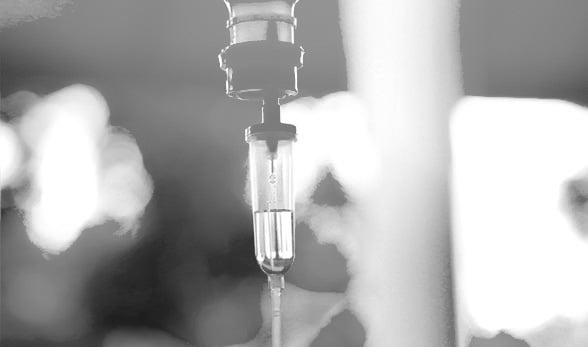Plagued by severe depression all his adult life, Aaron Serna has lived through years of ups and downs so low nothing could pull him out of the darkness. Job losses, failed relationships, forced hospitalizations and months of isolation and despair mark his 37 years of life, with thoughts of ending it planned out – all the way to the circled day on his calendar.
Supportive people and psychiatric holds always managed to push Serna past those marked dates. But the cycle never ended. No therapist, no drug, could banish the blackness that enveloped Serna’s life. But just over a year ago, the clouds cleared unlike they had ever done before. Serna tried ketamine, an anesthetizing drug commonly used in hospitals that has made its way into the mental health field.
See related articles:
“I lost a lot of productive time,” Serna said of his reasons for sharing his story publicly. “If other people can get help sooner, if people know there’s more resources out there than just the traditional ones, that’s information I want to share,” said Serna, a Denver resident who works in public service.
‘Always this emotional numbness’
Growing up gay in a conservative, evangelical Christian family in Texas, Serna struggled with emotions all his life. His depression and anxiety became more pronounced during the socially challenging high school years. Memories of his mother spending weeks in bed with deep depression suggest a biological predisposition for Serna.
“When you have depression, it’s not just sadness. It’s like not being able to feel anything at all. There was always this emotional numbness,” said Serna, who began cutting himself in his late teens “just to feel something.”
When he was 22 and starting graduate school, a traumatic breakup put him over the edge. “That plus the isolation of being in a new city and trying to go to grad school,” Serna said. “I was not dealing well.” He turned to alcohol, a common coping mechanism for mental health sufferers, and the self-cutting became life-threatening. That led to his first psychiatric hold.
“I ended up dropping out of school,” said Serna, who decided to move to Colorado to be a “ski bum for a season.” The depressive episodes followed, but Serna found a caring boyfriend, whose family took him in, supporting him to this day, even though the relationship ended. “He’s still one of my best friends.”
A stroke of luck
After years of ups and downs in Colorado, Serna was hospitalized for a third time, this time at Denver Health, which he now views as a stroke of luck. “The therapist I was assigned was amazing. I made a lot of progress mentally,” Serna said, emphasizing that finding the right therapist is just as important as finding the right therapy.
Through the years, Serna had tried the psychedelic drugs LSD and psilocybin (“magic mushrooms”) on his own to boost his mood with some success. “My mood would stay elevated a little for weeks to months afterward. I could think clearer. A little of that depression fog was lifted.”
“My mind was turned off for me, and I was just a thing experiencing my thoughts. I wasn’t my thoughts. There was something very peaceful about that.” – Aaron Serna, on his experience with ketamine therapy
Having found the right therapist was key, Serna said. “I was able to talk about that openly with her, and she was also interested in the use of psychedelics as treatment for depression, anxiety and PTSD and was following the research.”
Near the end of the pandemic shutdowns, anxiety and depression overcame Serna again. With his history of hospitalizations and treatment resistance, his psychiatrist proposed trying something different.
She suggested electroconvulsive therapy, transcranial magnetic stimulation or ketamine infusions, Serna said. While ketamine stood out as the least invasive for Serna, the two also agreed his experimental luck with other psychoactive drugs made him a good candidate for the therapy.
‘I wasn’t my thoughts’
The setting at the Denver ketamine infusion center his therapist recommended was like a doctor’s office but with more of a “spa feeling,” Serna said. He was hooked up to an IV and machines for monitoring blood pressure, heart rate and oxygen level. Ketamine (contraindicated for cardiac patients) can raise blood pressure. Because Serna’s did rise slightly with his first infusion, he was prescribed a blood-pressure lowering medication for the remaining sessions.
“They put you in this really comfy Lazy Boy chair.” Then Serna slipped on eye covers and headphones playing his own “instrumental-only music” as instructed, and the IV was started. Serna said he quickly began feeling the effects.

“I felt like my body was becoming very viscous.” Visions of colorful geometric patterns danced with the music in his head, along with memories from childhood and college. “But the memories never induced a negative feeling, and I felt like there was some benevolent female presence just there with me the whole time.”
A sense that his body was going to slide “down a pipe or something” persisted. “And then all of the sudden, it did,” Serna said. “At that point, you are just like gone. I had no concept of space or time or how long I was gone or where I was. I felt like I was moving through geometric-like rooms and spaces.”
Serna, who said his mental health issues make it hard for him to “turn off” his mind, called the 40- to 50-minute infusion experiences relaxing. “My mind was turned off for me, and I was just a thing experiencing my thoughts. I wasn’t my thoughts,” he said, likening it to a mediative state monks spend decades mastering. “There was something very peaceful about that.”
From gray to ‘technicolor’
A primary series of ketamine therapy involves six infusions spaced a few days apart. Doses are slowly increased, with Serna going from 40 mg to 85 mg from late January 2021 to late February. During his screening and at his initial treatment, Serna’s assessment for depression rated him “severe and high risk.”
His rating dropped progressively until March 9, after completion of his ketamine series, when he rated “none” for depressive symptoms. Serna said he felt the after-effects right away.

Before, when he would become really depressed, it felt like everything was dulled, from his emotions to his vision, he said. “Colors were dull. The mountains were dull. It’s hard to explain,” said Serna, who lived near Dillion Lake in the Colorado mountains at the time of treatment. “It’s one of the most beautiful places in the world.”
But Serna never saw it that way.
That is, until a run following his second ketamine treatment. “I was like, ‘Wow! This is so beautiful!’ It was like going from gray and dim colors to technicolor. I don’t know how it worked, but it did. I actually just recently came off my antidepressants, so according to my psychiatrist, my depression is in remission.”
‘It’s not a panacea’
But Serna still has regular talk therapy and a depression assessment with the ketamine center every two weeks to monitor need for a booster session. “It’s not a panacea,” Serna said. “It’s not going to fix everything. You still have to do the work.”
“It was like going from gray and dim colors to technicolor. I don’t know how it worked, but it did.” – Aaron Serna, on the after-effects of ketamine therapy
For Serna, that includes focusing on health, from eating right and getting enough sleep to exercising and reading self-help books, he said, adding that not exercising and not sleeping well trigger his symptoms.
With his ketamine sessions alone $300 each, Serna hopes heightened awareness about the benefits can lead to more research and Food and Drug Administration approval. Currently an off-label therapy (approved drug used for an unapproved condition), insurance seldom covers the treatment. Serna also wants to see all psychedelic research and therapies advanced.
“I do think there’s potential to help people with mental health issues, and if more people were talking about their experiences and being honest, I think maybe it could go a long way to destigmatize and decriminalize the use of these therapies.”



